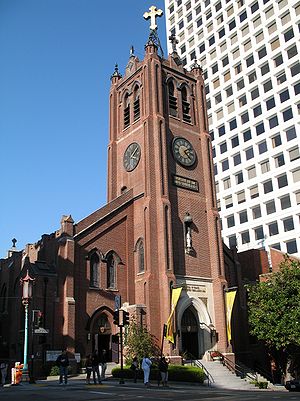One of the Easter vacations my family took when my kids were young was a trip to San Francisco. My husband was a Naval Reserve officer, and he got us into the Marines Memorial Club near Union Square downtown. It was a great location—convenient to many city attractions and to buses and cable cars.
I am usually lax about church attendance when we are on vacation. But not on Easter. It seems to me that Easter is the most important day of the year for Christians to recognize, and so I make every effort to get myself and my children to church on Easter. (My Methodist husband can fend for himself, but usually accompanies us on major holidays.)
But when we’re on vacation, I try to keep church attendance from interfering with our tourist activities. On our San Francisco trip, that meant going to Mass on Saturday evening—to the Easter Vigil service.
A Catholic Easter Vigil Mass is unlike any other Mass. It is scheduled after sunset and begins with the church in darkness. The new Paschal candle is blessed and lit, then deacons move around the church lighting the congregants’ candles until the dark church glows.
In yet another oddity, the service begins with seven readings, before the regular portion of the Mass even begins. In the typical Mass there are only three readings total.
Then, after all the Easter Vigil readings, new converts to Catholicism are baptized and confirmed. Only then does the typical consecration and communion take place, with the new Catholics joining the congregation in their first Eucharist.
Through all of this, there’s a lot of singing and incense.
As you might imagine, it all takes longer than a regular Mass—two hours instead of one.
I didn’t know any of this when I blithely led my reluctant family into the Easter Vigil Mass in San Francisco. My parents had never taken me to an Easter Vigil service, and my adult wanderings hadn’t either.
If I’d known how long the Mass would take, I probably wouldn’t have taken my grade school children, who were worn out from walking the streets of San Francisco. Of course, then I would have insisted that we spend Sunday morning in church, and they wouldn’t have liked that either.
I don’t recall which church we went to, but it was a grand old building near Chinatown, just a few blocks from the Marines Memorial Club. I think it was Old St. Mary’s Church, the original cathedral in San Francisco, originally dedicated at Christmas 1854.
I chose a pew, and my family and I filed in and sat. Soon a German family entered and sat next to us—parents and two teenage boys. I remembered enough of my high school German to understand a little of what they said as they talked quietly.
The service began in the darkened church. A procession. Readings. Lighting of the Paschal candle. More readings.
The German family began to fidget and to whisper among themselves. They grew more and more agitated.
Finally, the mother who was next to me tapped me on my arm. “Katholische Kirche?” she asked, clearly wondering if she was in fact in a Catholic church or had wandered into some strange cult. She must never have been to an Easter Vigil service either.
“Ja, katholische,” I responded in resignation, my rudimentary German sufficient to respond to her inquiry.
And both of our families stood and sat and knelt through the long liturgy. All the while, this American cradle Catholic was as bemused as our foreign visitors at the solemn pageantry and ritual we experienced. But the solemnity accentuated the importance of the occasion—the reason I had shepherded my family to the Mass.
When have you found yourself in an unfamiliar situation you didn’t expect?



Pingback: Falling In—Two Tales from Chesapeake Bay (or thereabouts) | Theresa Hupp, Author